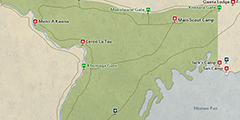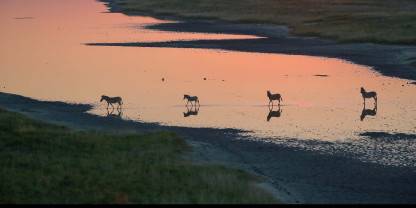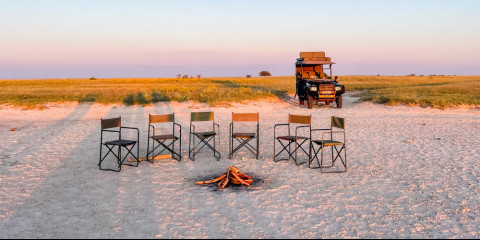Part of the Kalahari Basin, Makgadikgadi Pans National Park has some of the largest in the world. It is a mesmerizing landscape unlike anywhere else in Africa. The shimmering cracked crust doesn’t look like it could support any life. But it is magnificent at sunrise and sunset, and after good rains this desolate landscape transforms: from December to March, Makgadikgadi hosts one of Africa’s biggest zebra migrations. As the pans fill up, flocks of pelican and flamingo arrive too.

-
Best Time To Go
- All year (Areas are best at different times)
-
High Season
- July to October (Higher rates may apply but it’s not busy)
-
Size
- 3,900km² / 1,506mi²
-
Altitude
-
904-945m /2,966-3,100ft
 View Photos
View Photos
 View Photos
+24
Photos
View Photos
+24
Photos
 Open Map
Open Map
Pros & Cons
- Superb scenery unlike anywhere else in the country
- The park’s east is never crowded (except with zebra)
- Open plains in the east make wildlife viewing better
- Concentrations of animals at the Boteti River in the dry months
- Good range of accommodations along the Boteti River as well as northeast of the park
- Zebra migration to the pans in the wet months
- Less wildlife than in Chobe National Park or Moremi Game Reserve
- Not many accommodations in and around the park’s east
- Daytime temperatures can be very hot and dry, with no shade on the pans
The Zebra Migration
Zebras in their thousands migrate through the park with the seasons, accompanied by lots of wildebeest. The herds are usually out east around the pans (and north in neighboring Nxai Pan National Park) from December to March. Then they are around (or on their way to and from) the Boteti River from April to October. It’s an amazing spectacle, wherever you find them, as their barks fill the air and dust is raised by countless hooves while they keep on the move.
Wildlife
Most wildlife activity in the park is at the Boteti River, and this is where many of the lodges are situated. This area gets jam-packed with grazers in the drier months from June to December. Burchell’s zebra, blue wildebeest, greater kudu and giraffe all gather here. Lion and spotted hyena are regulars as well, but leopard is difficult to see. When the grass starts to grow in the Wet season, these animals migrate east to the pans.
More about Makgadikgadi Pans' wildlifeScenery
Makgadikgadi is a beautiful park, with its mix of Kalahari sand, and along the (often dry) Boteti River. Don’t miss the stunning views out over the riverbed from the steep banks of the Boteti at sunset. Out east, the pans are hallucinatory in scale and whiteness: it’s a beguiling, perspective-altering landscape encircled by trees and grassy islands.
Activities
The only activities permitted inside the park are guided and self-guided . Just outside the park, some of the lodges offer other activities. In the west, close to the Boteti River, this might include night drives. These are also possible in the pans just outside the eastern boundary of the park, where you can visit habituated meerkat populations in the company of a guide.
Weather & Climate
Makgadikgadi Pans has a desert climate with two distinct seasons. The Wet season (November to March) is consistently hot, with the average daytime temperature hovering around 36°C/97°F. Temperatures in the Dry season (April to October) are anything but consistent. They start off warm, drop to cool in the middle of the year, then crank up to very hot in October.
More about the weather and climateBest Time To Visit
Depending on the time of year you visit Makgadikgadi, you’ll spot different animals in different areas around the park. The wet summer months from November to April are the best time to see birds. If you’re lucky, you’ll see enormous flocks of flamingos gathering at the pans. The drier months from June to December are when herbivores and various predators head down to the Boteti River.
More about the best time to visit



